Carnegie-DIMM Software Documentation
Version 1.18
Christoph C. Birk (birk AT carnegiescience DOT edu)
Version 1.18
Christoph C. Birk (birk AT carnegiescience DOT edu)
Location of this document: http://instrumentation.obs.carnegiescience.edu/Software/CDIMM/cdimm.html
The CDimm-GUI has been re-written as native macOS/Cocoa GUI
#*/3 0-8,18-23 * * * $HOME/CDIMM/report -d $HOME/Sites/cdimm_state -a birk,gprieto,management.magellan@lco.cl both #*/20 9-17 * * * $HOME/CDIMM/report -d $HOME/Sites/cdimm_state state
Re-enabling the webpage update requires the following steps:
The following directory structure is hard-coded and has to be exactly as described here:
Directory\File Comment c:\Cdimm\Catalogs\ star catalogs used in sky-map dimm.cat subset of SAO star catalog dimm.idx sao.cat SAO star catalog [optional] sao.idx [optional] c:\Cdimm\Debug\cdimm.exe executable c:\Cdimm\ini\ setup files ccd5.ini description of ST5-CCD ccd7.ini description of ST7-CCD cdimm.ini DIMM-system setup telescope.ini telescope setup c:\Cdimm\Logfiles\ output directory for logfile c:\Cdimm\Objects\ object lists dimm.objects regular DIMM operations mass.objects MASS-DIMM operations c:\Cdimm\Release\cdimm.exe executable [optional] c:\Cdimm\SBIG\ SBIG library (development only) c:\Cdimm\src\ source files (development only) c:\Cdimm\cdimm.sln MS-VC solutions file (development only) c:\Cdimm\cdimm.vcproj MS-VC project file (development only)
name ST5 ; just a descriptive character string device lpt ; parallel port dimx 320 ; CCD width [pixels] dimy 240 ; CCD height [pixels] pixsize 10.0 ; pixel size [micro-meters] egain 1.25 ; electrons/ADU enoise 25.0 ; read noise [electrons] cfzm 2.0e8 ; counts-for-zero-magnitude (norm. to 10 inch aperture) satlev 30000 ; saturation level (15 bit ADC) temp-ccd 0.0 ; setpoint for temperature regulator
name ST7 ; just a descriptive character string device usb ; USB port dimx 765 ; CCD width [pixels] dimy 510 ; CCD height [pixels] pixsize 9.0 ; pixel size [micro-meters] egain 2.3 ; electrons/ADU enoise 15.0 ; read noise [electrons] cfzm 2.0e8 ; counts-for-zero-magnitude (norm. to 10inch aperture) satlev 60000 ; saturation level (16 bit ADC) temp-ccd 0.0 ; setpoint for temperature regulator
ident dimm0 ; first part of log/data file names
ccd-type ST7 ; {ST5,ST7}
tcs-online 1 ; {0,1} {simulator,real}
ccd-online 1 ; {0,1}
measure-time 60 ; length of each measurement [seconds]
star-radius 4 ; [pixels]
exp-long 0.050 ; exposure time for test exposure [seconds]
exp-t1 0.005 ; exposure time in DIMM-mode [seconds]
file-num 1 ; currrent FITS file number (tests only)
twilight -12 ; sun-altidude (start/stop condition)
am-limit 1.5 ; airmass limit (star selection)
optmag 2.5 ; preferred star magnitude (star selection)
vbin 10 ; vertical binning (ST7-scan mode)
mass-port uuuuu ; default=0 (no MASS)
mass-host x.y.z.host ; IP number of computer running 'turbina' (optional)
v1.06 and later:
dome-host x.y.z.host ; IP number of 'Acromag' controlling the dome (optional)v1.08 and later:
auto-dimm 0 ; start DIMM measurements at program startup (default=0)v1.09 and later:
verbose 0 ; default=0 (verbosity of logfile)v1.12 and later:
massfov-x1 312 ; restricted MASS field of view (ST-7 specific) massfov-x2 451 massfov-y1 213 massfov-y2 433v1.13 and later:
auto-save C:\Data ; save scan-exposures, default="" (not used)v1.14 and later:
auto-setup 1 ; power-up CCD/telescope at startup (default=1) auto-dome 1 ; open/close dome in AutoDIMM mode (default=1)v1.15 and later:
meteo-host1 mag2tcs ; Magellan domes used as weather indicator meteo-host2 mag1tcs ; default="" (not used) wind-limit 35 ; default=30v1.16 and later:
spiral-size 1 ; {0,1,2,3,4} default=0 (auto)
v1.17 and later:
fthreshold 0.5 ; focus correction threshold [pixels] (default=1) cthreshold 10 ; re-center threshold [arcsec] (default=15)
name LX200GPS ; descriptive name (LX200 supported only) device com1 ; serial port baudrate 9600 parity N bits 8 tellong -118.1 ; [deg] longitude tellat +34.1 ; [deg] latitude diameter 0.254 ; [m] full diameter (10 inch) f-ratio 9.9033 ; focal-ratio aperture 0.095 ; [m] sub-aperture diameter separation 0.150 ; [m] sub-aperture separation spread 40.0 ; star-separation in best focus [arcsec] fspeed 0 ; [pixel/sec] focus-motor speed pa-offset 180 ; [deg] CCD orientation on sky gps 0 ; GPS working (1=yes) az-limit1 0 ; [deg] azimuth limits (star selection) az-limit2 360 ; [deg] zd-limit 5 ; [deg] min. zenith distance (star selection)v1.07 and later:
time 0 ; use telescope time for log/data-files (default=0)v1.14 and later:
safe-az 187.783 ; azimuth parking position (default: not used) safe-el -0.133 ; elevation parking position (default: not used)
Notes:
fspeed: Please set this to a slightly smaller value than
the measured value to avoid
over-shooting in the auto-focus control loop.
Name | Alpha (R.A.) | Delta (Dec.) | Equinox | Vmag Rmag | Comment HR-0025 | 00:09:24.7 | -45:44:51.0 | 2000.0 | 3.880 3.130 | E PheThe current list (dimm.objects or mass.objects) is displayed in the ObjectList-Window.
To verify the functioning of the CCD system you may press the
Expsose button to take a single exposure. For a detailed
explanation of all GUI controls please refer to the
GUI Controls
section.
This window displays the SAO (default) star-catalog, superimposed
with the object list. The stars are represented by colored circles.
Spectral types 'O','B' are blue, 'A','F' are green, 'G' is yellow,
'K' is red and 'M' is brown. Unknown spectral types are colored in black.
Entries from the ObjectList are small pink circles
with a blue cross and the object's name printed next to it.
A left mouse-click on the sky area (grey) selects the nearest star
and displays its catalog number, spectral type (if available) and
visual magnitude.
A right double-click selects the nearest star and moves the
telescope to it.
This window displays the current
object list.
It allows the user to add, modify and remove entries.
The list may be sorted by various (see below) criteria.
This window displays various data collected since the last
program start. The vertical 'triangle-buttons' adjust the y-scale,
while the horizontal 'triangle-buttons' adjust the time-scale.
The 'message-window' displays mostly information about the
current procedure. The time is given as 'local time'.
This window displays the current (red dot) and future (blue line)
airmass at the current telescope pointing.
The C-DIMM software creates 3 data-files per day:
The .see file contains the final measurements (eg. seeing);
the .t12 file contains more detailed values and intermediate
numbers and the .wnd file contains the current wind data.
ST-5:
dimm1_06Jul2006_5.see (1 line per measurement)
ST-5:
dimm1_06Jul2006_5.t12 (1 line per measurement)
ST-7:
dimm1_06Jul2006_7.see (1 line per measurement)
ST-7:
dimm1_06Jul2006_7.t12 (6 lines per measurement, one for each time-bin)
ST-7:
dimm1_30Jun2011_7.wnd (1 line per measurement)
The logfile contains useful information about all procdures.
It content is mainly for testing and debugging purposes. The
naming convention is the same as for the data files
(eg. dimm1_06Jul2006_7.log).
ST-5:
Each logfile starts with the current epoch, the moon-phase,
the name of the data files and the setup:
The individual results for both expsoure times,
focus (dx), alignment (dy), some intermediate numbers and
the finals results:
ST-7:
Each logfile starts with the current epoch, the moon-phase,
the name of the data files and the setup:
Some results of the FourierTransform (may be safely ignored):
Assuming all systems are working, all one has to do to start
the DIMM measurements is to press the AutoDimm button.
This will start the following sequence:
(see cdimm.c:DimmLoopTimerFunc)
GUI Controls
DIMM Window
ST5: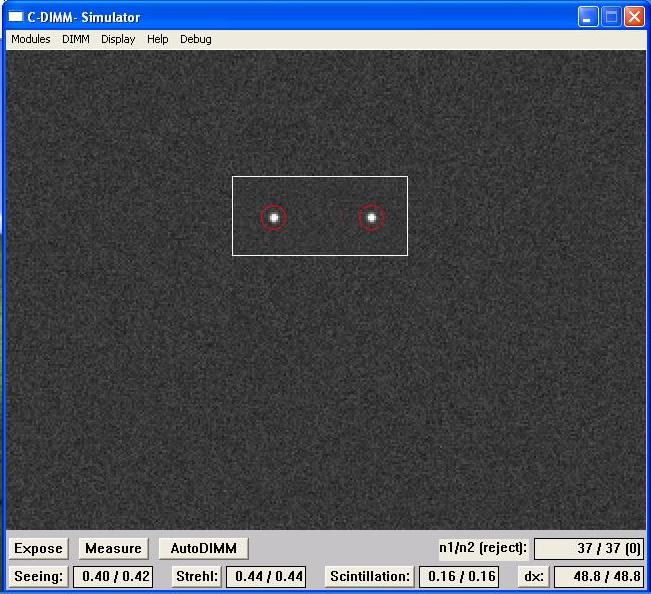
ST7: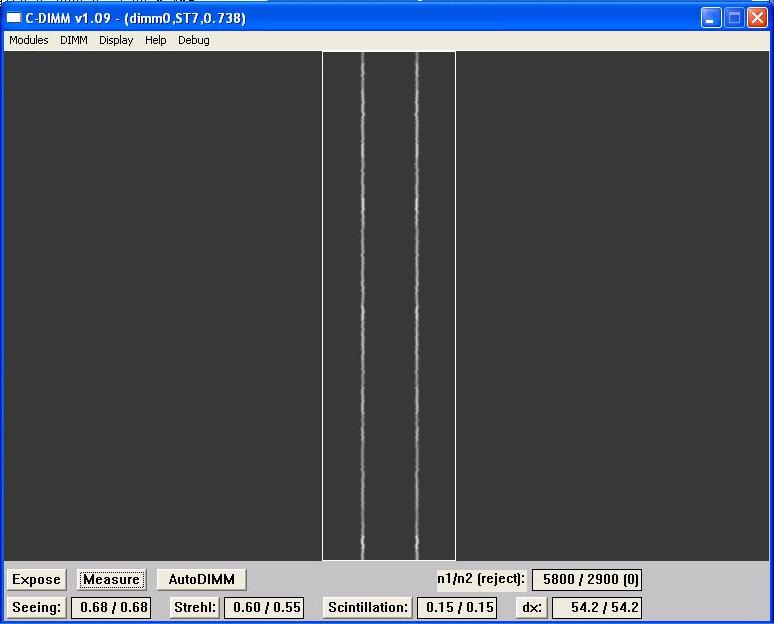
ExpLong
Exposure time [ms] used for centering and manual exposures. Exp-T1
Short exposure time (ST5) [ms] for seeing measurements.
Scan interval in ST-7 scan mode. MeasureT
Length [seconds] of measurement loop (data acqisition). StarRadius
Radius for object fit during data analysis. Focus
Best star-separation in pixels. Equivalent of 'spread' [arcsec] in
telescope.ini
WARNING: This value is not saved between
runs of the program. For permanent changes please update
telescope.ini. V-binning
Vertical binning in scan-mode (ST7).
Strehl
Simulator (input) strehl-ratio Spread
Simulator (input) star separation Seeing
Simulator (input) seeing Scintillation
Simulator (input) scintillation f-Cosmics
Frequency of (simulated) cosmic events per readout line PointingError
RMS pointing error of the (simulated) telescope
Clounds
magnitudes of (simulated) absorption F-Motion
Intrinsic freqency of (simulated) star motion
Telescope Window
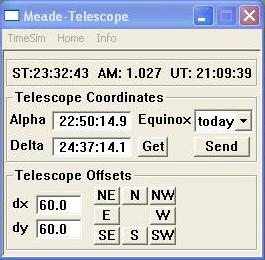
The first groups shows the current siderial time (ST), airmass (AM)
and universal time (UT).
The seconds group handles telescope coordinates:
The third group handles small telescope motions (offsets)
Skymap Window
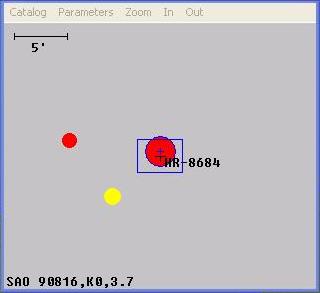
In the example above the star SAO-90816 (spectral type K0, Vmag=3.7)
is identical to the object 'HR-8684'.
Mag.Limit
Object-List Window
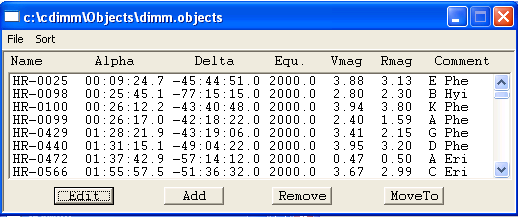
Data Graph Window
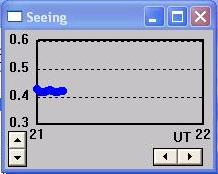
The following graphs are available:
Message Window
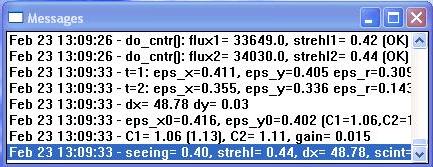
In the example above the first 2 lines are printed during
the centering and give the flux and strehl-ratios of the star pair.
The next 2 lines are the intermediate results of the short (t=1)
and the long (t=2) exposure sequence (ST5-mode) ...
Airmass Window
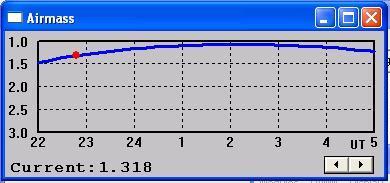
MASS Operation
The C-DIMM software can control a MASS system that is mounted at the
same telescope as the DIMM. If the following keywords are present in the
cdimm.ini file:
mass-port uuuuu ; default=0 (no MASS)
mass-host x.y.z.host ; IP number of computer running 'turbina' (optional)
then the C-DIMM software will:
There is no necessity of running a supervisor program if you
are using C-DIMM.
Output Files
Data Files
ST-5
ST-7
name_ddmmmyyyy_c.see
name_ddmmmyyyy_c.t12
name_ddmmmyyyy_c.wnd
name
value of the ident keyword in the cdimm.ini
file (eg. 'dimm1') dd
2 digit day-of-month (eg. '06') mmm
3 letter abbreviation of the current month (eg. 'Jul') yyyy
4 digit year (eg. 2006) c
1 digit code for the CCD-type ('5' or '7')
Col-1 2 3 4 5 6 7 8 9 10 11 12
2006-07-06 23:01:50 4554 G_UMa 1.12 106 0.658 0.659 0.656 13694 48.8 -0.0
2006-07-06 23:02:50 4554 G_UMa 1.12 106 0.739 0.744 0.734 14390 48.8 0.0
2006-07-06 23:03:50 4554 G_UMa 1.12 106 0.593 0.595 0.590 14279 48.8 0.0
Columns (_5.see)
Col-1 2 3 4 5 6 7 8 9 10 11 12 13 14 15 16 17 18 19 20 21 22 23
4554 2006-07-06 23:01:50 53 0.629 0.629 0.629 13694 0.030 0.179 0.178 0.565 0.551 53 0.618 0.620 0.615 29454 0.012 0.121 0.122 0.561 0.552
Columns (_5.t12)
Col-1 2 3 4 5 6 7 8 9 10 11
2006-07-07 05:25:55 6705 G_Dra 1.09 1800 0.688 0.752 0.757 15107 54.2
2006-07-07 05:37:55 6705 G_Dra 1.08 1800 0.688 0.751 0.755 15372 54.2
2006-07-07 05:49:55 6705 G_Dra 1.07 1800 0.689 0.750 0.759 15251 54.2
Columns (_7.see)
Col-1 2 3 4 5 6 7 8 9 10 11 12
6705 2006-07-07 04:37:55 5 1774 0.675 15445 0.003 0.146 0.146 0.590 0.598
6705 2006-07-07 04:37:55 10 888 0.609 30896 0.002 0.144 0.144 0.584 0.593
6705 2006-07-07 04:37:55 15 592 0.536 46359 0.001 0.143 0.143 0.578 0.588
6705 2006-07-07 04:37:55 20 445 0.470 61813 0.001 0.140 0.140 0.572 0.584
6705 2006-07-07 04:37:55 25 356 0.428 77253 0.001 0.139 0.140 0.569 0.582
6705 2006-07-07 04:37:55 30 296 0.384 92726 0.001 0.137 0.138 0.565 0.581
Columns (_7.t12)
Col-1 2 3 4 5 6
2011-06-30 20:35:58 20.1 182 1.093 0.701
2011-06-30 20:36:10 20.1 182 1.160 0.701
2011-06-30 20:36:22 20.2 177 1.214 0.701
Columns (_7.wnd)
Logfile
ST-5
ST-7
At startup the C-DIMM software writes a complete description
of the current setup to the logfile. Some items are self-explanatory
but many are fairly cryptic. Below are examples that hopefully
explain most of the entries:
Jul 06 15:59:26: epoch= 2006.512
Jul 06 15:59:26: moon-phase= 0.710
Jul 06 15:59:26: c:\cdimm\Logfiles\dimm0_06Jul2006_5.see
Jul 06 15:59:26: c:\cdimm\Logfiles\dimm0_06Jul2006_5.t12
Jul 06 15:59:26: CCD: simulator, TCS: simulator
CCD, width, height, plate-scale, electrons/ADU,
readnoise [electrons], CFZM, preferred star magnitude:
Jul 06 15:59:27: ST5, 320, 240, 0.820, 1.25, 25.00, 2.80e+007, 2.5
Star separation [arcsec], focus [pixels]:
Jul 06 15:59:27: tpar.spread=40.00 [arcsec], spar.spread=48.78 [pix]
Telescope name, longitude, latitude,
aperture diameter [m], aperture separation [m]:
Jul 06 15:59:27: LX200GPS, -118.100, 34.100, 0.095, 0.150
Some numbers for the seeing calulation:
Jul 06 15:59:27: Kx=0.195, Ky=0.117, k2=1.580e-011, ta_98=11.142
Jul 06 15:59:27: shapefactor=192, ron2=400.0, nbpix=49
Theoretical strehl-ratio,
diffraction limit [arcsec], and the peak CCD sensitivity [nm]:
Jul 06 15:59:27: strehl_th=0.229, diff_lim=2.261, lambda_ccd=700
The startup ... no errors:
Jul 06 16:01:20: ccd_init()
Jul 06 16:01:20: tele_init()
Jul 06 16:01:33: dome open
The star-selection process: azimuth, airmass, zenith-distance,
mag-difference, moon-distance, #rejections determine the cost.
Jul 06 16:01:34: 38: az=20, am=1.0, zd=7, dm=0.5, md=97, re=0, cost=1.33
Jul 06 16:01:34: 40: az=44, am=1.0, zd=10, dm=0.5, md=91, re=0, cost=1.74
Jul 06 16:01:34: 41: az=129, am=1.1, zd=14, dm=0.1, md=74, re=0, cost=2.15
Jul 06 16:01:34: 43: az=124, am=1.2, zd=20, dm=-0.4, md=64, re=0, cost=2.07
Jul 06 16:01:34: 44: az=36, am=1.1, zd=20, dm=-0.1, md=91, re=0, cost=0.59
Jul 06 16:01:34: 46: az=39, am=1.2, zd=22, dm=-0.7, md=86, re=0, cost=0.66
Jul 06 16:01:34: 47: az=110, am=1.4, zd=23, dm=0.3, md=47, re=0, cost=2.04
Jul 06 16:01:34: 48: az=52, am=1.4, zd=15, dm=-0.6, md=75, re=0, cost=0.87
And the winner is ... (required min. flux/sec from star-magnitude and CFZM):
Jul 06 16:01:34: #44-HR-4554: az=36, am=1.1, zd=20, dm=-0.1, md=91
Jul 06 16:01:38: new object: HR-4554 - G UMa
Jul 06 16:01:38: new min_flux=486194
The centering process prints the measured flux and strehl-ratio:
Jul 06 16:01:38: do_cntr(): flux1= 155479.0, strehl1= 0.55 (OK)
Jul 06 16:01:38: do_cntr(): flux2= 155199.0, strehl2= 0.56 (OK)
Jul 06 16:01:40: centering done, have_dimmstar=1
Each measurement loop starts with a check of the stars position:
Jul 06 16:01:40: do_cntr(): flux1= 136687.0, strehl1= 0.57 (OK)
Jul 06 16:01:40: do_cntr(): flux2= 137446.0, strehl2= 0.57 (OK)
taking data ...
Jul 06 16:01:50: t=1: eps_x=0.674, eps_y=0.674 eps_r=0.0326
Jul 06 16:01:50: t=2: eps_x=0.664, eps_y=0.659 eps_r=0.0130
Jul 06 16:01:50: dx= 48.77 dy= -0.01
Jul 06 16:01:50: eps_x0=0.706, eps_y0=0.703, zcorr=0.933
Jul 06 16:01:50: C1= 1.033 (1.014), C2= 1.06, gain= 0.250
Jul 06 16:01:50: seeing=0.66, strehl=0.56, dx=48.77, scint=0.261
Jul 06 11:36:04: epoch= 2006.512
Jul 06 11:36:04: moon-phase= 0.696
Jul 06 11:36:04: c:\cdimm\Logfiles\dimm0_06Jul2006_7.see
Jul 06 11:36:04: c:\cdimm\Logfiles\dimm0_06Jul2006_7.t12
Jul 06 11:36:04: CCD: simulator, TCS: simulator
CCD, width, height, plate-scale, electrons/ADU,
readnoise [electrons], CFZM, preferred star magnitude:
Jul 06 11:36:04: ST7, 765, 510, 0.738, 2.30, 15.00, 2.80e+007, 2.5
Star separation [arcsec], focus [pixels]:
Jul 06 11:36:04: tpar.spread=40.00 [arcsec], spar.spread=54.20 [pix]
Telescope name, longitude, latitude,
aperture diameter [m], aperture separation [m]:
Jul 06 11:36:04: LX200GPS, -118.100, 34.100, 0.095, 0.150
Some numbers for the seeing calulation:
Jul 06 11:36:04: Kx=0.195, Ky=0.117, k2=1.280e-011, ta_98=11.142
Jul 06 11:36:04: shapefactor=60, ron2=42.5, nbpix=9
Theoretical strehl-ratio,
diffraction limit [arcsec], and the peak CCD sensitivity [nm]:
Jul 06 11:36:04: strehl_th=0.232, diff_lim=2.243, lambda_ccd=625
The startup ... no errors:
Jul 06 11:36:04: tele_init()
Jul 06 11:36:04: ccd_init()
Jul 06 21:19:55: dome open
The star-selection process: azimuth, airmass, zenith-distance,
mag-difference, moon-distance, #rejections determine the cost.
Jul 06 21:19:56: 54: az=167, am=1.0, zd=7, dm=-0.3, md=51, re=0, cost=2.79
Jul 06 21:19:56: 55: az=171, am=1.1, zd=28, dm=0.1, md=31, re=0, cost=2.86
Jul 06 21:19:56: 57: az=128, am=1.1, zd=13, dm=0.3, md=48, re=0, cost=2.35
Jul 06 21:19:56: 60: az=104, am=1.1, zd=9, dm=0.6, md=56, re=0, cost=3.47
Jul 06 21:19:56: 62: az=41, am=1.1, zd=18, dm=0.3, md=82, re=0, cost=0.90
Jul 06 21:19:56: 64: az=125, am=1.4, zd=30, dm=0.3, md=45, re=0, cost=2.31
Jul 06 21:19:56: 66: az=46, am=1.2, zd=17, dm=-0.3, md=84, re=0, cost=0.76
And the winner is ... (required min. flux/sec from star-magnitude and CFZM):
Jul 06 21:19:56: #66-HR-6705: az=46, am=1.2, zd=17, dm=-0.3, md=84
Jul 06 21:23:56: new object: HR-6705 - G Dra
Jul 06 21:23:56: new min_flux=584534
The centering process prints the measured flux and strehl-ratio:
Jul 06 21:24:56: do_cntr(): flux1= 140765.0, strehl1= 0.53 (OK)
Jul 06 21:24:56: do_cntr(): flux2= 139987.0, strehl2= 0.50 (OK)
Jul 06 21:25:56: centering done, have_dimmstar=1
Each measurement loop starts with a check of the stars position,
and determination of the best (vertical) binning factor:
Jul 06 21:26:56: do_cntr(): flux1= 142508.0, strehl1= 0.53 (OK)
Jul 06 21:26:56: do_cntr(): flux2= 142095.0, strehl2= 0.51 (OK)
Jul 06 21:27:55: cntr_y=252.7
Jul 06 21:27:55: vbin=10
taking data ...
Jul 06 21:37:55: cp=15.8 (512)
Jul 06 21:37:55: local peak at 2.0 (0.325)
Jul 06 21:37:55: local peak at 5.5 (0.373)
Jul 06 21:37:55: local peak at 7.8 (0.605)
Jul 06 21:37:55: local peak at 27.5 (0.533)
Jul 06 21:37:55: local peak at 33.8 (0.633)
Jul 06 21:37:55: local peak at 47.7 (0.246)
Jul 06 21:37:55: np=6 (256), cf=20.7
The individual results for each time-bin
(uncorreced seeing and noise-contribution):
Jul 06 21:37:55: t=1: eps_x=0.734, eps_r=0.0028
Jul 06 21:37:55: t=2: eps_x=0.662, eps_r=0.0018
Jul 06 21:37:55: t=3: eps_x=0.583, eps_r=0.0014
Jul 06 21:37:55: t=4: eps_x=0.511, eps_r=0.0012
Jul 06 21:37:55: t=5: eps_x=0.466, eps_r=0.0011
Jul 06 21:37:55: t=6: eps_x=0.418, eps_r=0.0010
Some intermediate numbers and the final results:
Jul 06 21:37:55: 1-dim FWHM=2.55 (0.013)
Jul 06 21:37:55: C1= 1.050 (1.081), C2= 1.09, gain= 0.250
Jul 06 21:37:55: eps_mod=0.736, eps_ex2=0.815, eps_ex6=0.823, zcorr=0.920
Jul 06 21:37:55: seeing= 0.677, strehl= 0.59, dx= 54.20, scint= 0.147
Jul 06 21:37:56: auto-focus= 54.20 (+0.000)
References